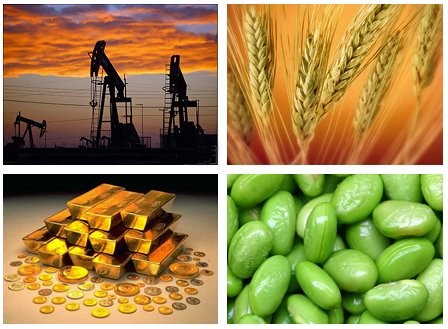Commodity Mutual Funds A Beginner s Guide
Post on: 31 Май, 2015 No Comment

Types of Commodity Mutual Funds
There are different types of commodity mutual funds just as there are different types of commodities. These can include:
- Commodity Futures
These funds are commodity-linked derivative instruments that give similar exposure to commodities without actually taking delivery of the commodity. Futures are one way to achieve this; however, the futures market can be very volatile and direct investment in these markets can be very risky.
- Index Funds
These funds follow an index that tracks various commodities depending on the asset class. Examples would be funds that track the Dow Jones AIG Commodities Index.
- Natural Resource Funds
Natural Resource Funds are as the name suggests, funds that invest in companies that have exposure to commodities. They can be energy companies, mining, drilling, or agriculture. While not giving direct exposure to actual commodities, they give an investor exposure indirectly.
- Combination Funds
These hold both actual commodities and commodity futures. Silver funds, for example, may hold actual silver bullion in combination with futures contracts.

- Commodity Funds
These funds are truly commodity funds in that their portfolio is made up of physical commodity assets. For example, holding silver.
Benefits of Owning Commodity Assets Through Mutual Funds
Commodity funds offer different types of investment strategies, including active and passive management. Active management portfolios try to outperform an index while passive management aims to replicate an index. Further, by investing in a commodity mutual fund, investors can have a portfolio component that is not a stock, bond or an investment vehicle that focuses on those asset classes.
Commodities also provide a hedge against inflation. During inflationary times, commodity prices often go up while the market price of stocks often go down. This occurs because inflation is usually associated with higher interest rates and this makes borrowing more expensive for companies. As interest expenses rise, net profit drops, and the share price of companies sink.
Investing in a commodity mutual fund is also much cheaper and easier than investing in commodity futures.
Other Considerations
Remember that all the standard investment warnings apply to commodity mutual funds as with any investment. Perform your own due diligence to ensure that the fund’s fee structure does not take away too much of the investment return. Also ensure that the fund objective matches your risk tolerance, and look for a strong track record, although historical returns are not always the best prediction for future returns.
Lastly, be aware that many commodity mutual funds invest in stocks, so they are not a pure play on commodity prices.
Most Popular Commodity Mutual Funds/Index Funds
Some of the most well-known commodity mutual funds/index funds include the following:
- Dow Jones AIG Commodities Index (DJ-AIGCI)
This fund is a rolling commodities index that is comprised of 19 physical commodities traded on exchanges. It is typically seen as the benchmark for the commodities’ asset class. Its goal is to maintain low volatility and sufficient liquidity.
- Rogers International Commodities Index (RICI)
The index tracks 38 commodity futures contracts from 13 international exchanges. It is split into three segments: agriculture – 34.90. energy- 44.0%, and metals 21.1%, according to the RICI Handbook. Each month each commodity is rebalanced towards weights determined by the RICI committee.
- PIMCO Commodity Real Return Strategy (PCRIX)
PIMCO is well-known as the world’s largest bond fund. The PIMCO Commodity Real Return Strategy fund invests in commodity-linked derivative instruments backed by a portfolio of inflation-indexed securities and other Fixed Income Instruments. In other words, it’s an active management-based fund that tries to beat its benchmark.
- Oppenheimer Real Asset Fund (QRAAX)
This fund offers investors a unique alternative to traditional equity and fixed-income mutual funds with good diversification. Its benchmark is the GSCI, or the Goldman Sachs Commodity Index. Its strategy is to gain direct exposure to commodities through commodity-linked bonds tied to the value of the GSCI. By doing this it is able to put up just one-third of its assets to gain 100% commodity exposure. The rest of the money gets invested in short-term high-grade bonds that also generate a return. However, the fund’s returns can be unpredictable and the fund is very reliant on the price of oil, with nearly 70% of its exposure tied to energy prices.
- Deutsche Bank Liquid Commodities Index (DBLCI)
This fund tracks the performance of six commodities in the energy, precious metals, industrial metals and grain sectors. The DBLCI has constant weightings for each of the six commodities and is rebalanced once a year in November. The six commodities are WTI crude oil, heating oil, aluminum, gold, corn, and wheat.
- S&P GSCI Commodity Index (SPGSCI)
This fund is composed of 24 different commodities in a way that is proportion to their production in the world economy. This means it is heavily weighted in energy with approximately 70% of the fund dedicated to those commodities as of July 2014. A further 15% of the fund is focused on agriculture.
The Bottom Line
There are many different types of commodity investments for any kind of investor. Anything from commodity futures contracts that provide the most direct way to invest in commodities to commodity mutual funds that provide diversification, and other types of investments with varying risk and reward profiles. The important thing is to invest with the fund that provides the right balance of risk and reward for your investment profile.














